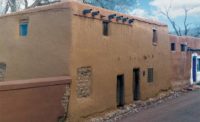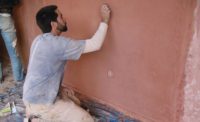Fibrous plaster is the common name in the Great Britain for the type of plasterwork that is more commonly referred to as plaster moldings or occasionally pre-cast plaster in North America. However, fibrous plastering I would maintain is a more accurate description as this technique in plaster working is used not only for the extrusion of molding profiles but also for ornament and panels among other casting applications. As the name implies, plasterwork of this variety is reinforced with fibers. Traditionally, these are derived from grasses and plants such as hemp, jute, sisal and even coconut.
Additionally, wood wool (aka excelsior, typically that of Aspen and Poplar) is in common use for many plaster applications. All of these could be thought of as serving a similar function that rebar provides concrete, that of reinforcing the plaster and increasing its tensile strength.
A Description of Materials and Technique
The selection of a suitable woven cloth, typically an hessian otherwise known as burlap, is rather straightforward. The weave of the cloth should neither be so open that it could be easily rended by hand nor so tightly woven that the plaster would have difficulty in passing through. Whereas burlap sacks for storing coffee beans and other commodities are examples of cloths too tightly woven, those available at most garden shops commonly used for ground cover typically serve the purpose adequately, are inexpensive and commonly available in smaller bolts or in bulk. Burlap is used almost exclusively with gypsum plaster. Hydraulic lime and cements are highly alkali and will quickly degrade most organic fibers and thus require other options for reinforcement that we will subsequently consider.
In preparation for running plaster moldings on a bench, strips of burlap are cut beforehand with shears. They can be either in segments or the full length of the molding. In any case they should be considerably narrower than the width of the molding. As gypsum plaster expands upon setting, the burlap will be carried toward the surface and edges in that expansion and can risk spoiling the work. Typically for bench run moldings, a small thickness of plaster is laid down and dry lengths of burlap are brushed into the plaster until completely saturated. Depending upon the thickness of the molding several layers can be thus applied. As saturated burlap can take almost any shape, it can be quite useful for quickly building up a molding that has one or more conspicuously thick elements in the profile.
The technique for reinforcing cast lengths of moldings follows a similar pattern to running them but in reverse. Plaster is first poured into the mold and then is “backed up” with burlap which is brushed into the molding at least 1/4 inch away from the face.
Sometimes when casting capitals, corbels and a variety of ornamental pieces it is useful to employ a slightly different technique or reinforcement. After applying a gel coat (a plaster coating of approximately 1/4 inch to the face of the piece) small pieces of burlap prepared in advance are first soaked in plaster and applied to the back in many layers. This method reduces consumption of plaster, weight of the piece while simultaneously increasing tensile strength. This becomes not just desirable but a necessary technique when dealing with larger pieces, particularly those to be suspended from ceilings.
Highest and Best Use of Fibrous Plastering
As the millwork industry became increasingly sophisticated, soft “paint grade” woods such as pine and poplar began to displace plaster as the economic plain molding specification. The integration of ornament enrichment into moldings slowed this transition until ornament itself was largely stripped from architectural design in the mid-20th century. Nevertheless, there are many strong arguments for utilizing plaster moldings with the following specifications often being competitive or less expensive:
Medium to large curvilinear profiles
Non-radial curvilinear profiles
Large, complex crown moldings
Curvilinear oriented moldings
Ornament
Low maintenance
Straight moldings can be produced just fine in plaster but it excels like no other medium in being able to contour to curvilinear shapes. I say curvilinear as opposed to radial because plaster is not constrained physically or economically to arcs of circles but can readily accommodate ellipses, hyperbolae, or free formed curves. The process helps to explain this property.
The first step in creating a plaster molding is hand-cutting a reverse metal profile from a template. The profile is mounted on a jig and the plaster is built up in successive layers on a table or ramp. For plaster, it matters little if the profile is large or small, complex or composed of non-radial curvilinear elements. In fact, the molding itself can be curvilinear such as the vertical orientation of an architrave surrounding an arch, horizontally as for molding applied against a curvilinear surface or even complex helical shapes as sometimes encountered in the stringers of descending staircases.
With a returning interest in traditional architecture there has been a corresponding interest in plaster ornamentation. As with plaster molding profiles, the work of plaster ornamentation is by hand so there are no mechanical constraints. Often much time is invested in a single model of high quality from which a mold is produced. Multiple plaster casts can be easily and economically produced. The more detailed the enrichment and the more units produced, the more value can be achieved with ornamentation.
Fibrous plastering in particular is well suited to contemporary construction. Like other moldings, much of the work lies in the production which can be carried out off-site in the shop. For installation the moldings and ornament are affixed to a plaster surface (including drywall) with plaster as the principal adhesive resulting in a monolithic finish of like materials that do not suffer from differentiating rates of expansion and contraction with ambient changes in temperature and humidity. In layman’s terms: plaster pieces applied to plaster walls and ceilings with plaster as the glue doesn’t crack.
GFRG & GFRC
These acronyms stand for Glass Fiber Reinforced Gypsum and Cement respectively. This is a slight modification of traditional means and methods utilizing modern industrial materials. In the case of GFRG an autoclaved gypsum plaster is often used that has significantly higher compressive strength and impact resistance. In the GFRG process, castings are reinforced with several layers of a thin fiberglass veil imparting both strength and flexibility. This plaster can be ideal for bases, column shafts and other plaster pieces that may be specified in public, high traffic areas such as lobbies and hallways.
The GFRG technique is also utilized to produce large and strong yet lightweight and flexible pieces such as domes, vaults and coves that can be suspended from behind with steel cables tied off from integrated hangers to metal channels in the ceiling. When cementitious materials are used the technique is called GFRC. Special care must be made to use only alkali resistant scrim or loose glass fibers when working with cement.
If you are an architect, designer or contractor seeking to understand and properly specify traditional plaster, I would recommend that you include an experienced plasterer in the design development phase of your project. It will open up beautiful design opportunities while supporting you in fulfilling your fiduciary responsibility with you or your client’s budget.




.jpg?height=200&t=1625764395&width=200)

